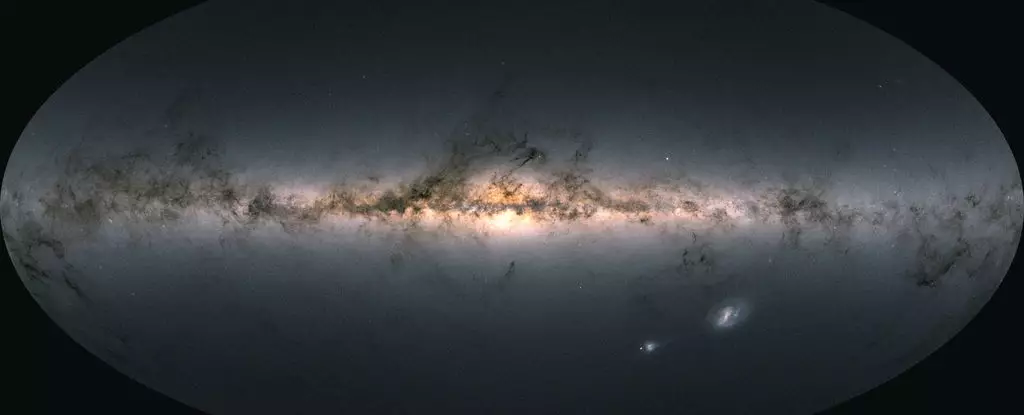Recent astronomical discoveries have unveiled the intriguing possibility of a hidden supermassive black hole residing in the Large Magellanic Cloud (LMC), a dwarf galaxy that spirals around the Milky Way. This revelation hints at a collision course not only between the two galaxies but also between their respective central black holes, which could drastically alter our understanding of galactic evolution and black hole formation. The sheer magnitude of this finding, indicating a mass approximately 600,000 times that of the Sun, introduces fresh questions regarding how black holes grow over cosmic time.
Black holes, despite their immense mass and gravitational pull, are notoriously difficult to detect. They do not emit light in a way that would allow easy observation unless they are actively feeding on surrounding matter. This feeding process generates high-energy radiation, which can be detected through telescopes. Typically, researchers identify these enigmatic entities by observing the motion of nearby stars and the gravitational influences exerted by an unseen mass. Most famously, in the case of Sagittarius A*, the Milky Way’s supermassive black hole, scientists inferred its presence through the orbits of stars in close proximity.
Jiwon Jesse Han and his team from the Harvard & Smithsonian Center for Astrophysics have approached the problem from a different angle. Rather than focusing exclusively on orbiting stars, they zeroed in on hypervelocity stars—objects that travel at speeds significantly higher than their galactic peers. These stars, propelled through the galaxy seemingly at will, could provide clues to the existence of massive black holes.
Hypervelocity stars are a fascinating phenomenon, often resulting from complex gravitational interactions. The Hills mechanism suggests that when a black hole interacts with two stars, one can be catapulted away at extraordinary speeds. Han’s research utilized data from the recently retired Gaia space telescope, which meticulously mapped stellar positions and velocities in three dimensions. By analyzing a particular set of 21 hypervelocity stars, the researchers were able to trace their origins and establish a compelling link to the LMC.
Of the hypervelocity stars studied, the team discovered that while some had trajectories leading back to the heart of the Milky Way, a subset traced their roots to the Large Magellanic Cloud. The combination of these findings pointed towards the presence of a massive, yet unobserved, black hole within the LMC.
The Large Magellanic Cloud currently orbits the Milky Way at a distance of approximately 160,000 light-years, charting a slow dance towards an eventual merger. Current estimates suggest that this encounter may occur in about 2 billion years. The implications of such a collision could be profound, particularly if the black hole in the LMC merges with the Milky Way’s central black hole, Sagittarius A*. Such an event would result in a significantly larger black hole, potentially providing insights into the growth mechanisms of these cosmic giants.
Understanding how black holes evolve is crucial for comprehension of the broader cosmic landscape. This discovery not only offers a new point of reference for stellar evolution models but also raises questions regarding the formative processes of supermassive black holes. If confirmed, it would also bolster existing theories about how smaller black holes coalesce into larger entities through galactic mergers.
While exciting, the existence of this hidden black hole is still awaiting confirmation. Ongoing research will be essential in determining the properties and characteristics of this object. The questions arising from this study could pave the way for future explorations that might integrate advanced observational technologies and deeper investigations into hypervelocity stars and their origins.
The potential collisions on the horizon offer astronomers a unique observational scenario, illustrating processes that may be ongoing elsewhere in the universe. As scientists piece together the data from the LMC and its intricate galactic dance with the Milky Way, they continue to unravel the complexities of black hole formation and cosmic evolution.
The prospect of a massive black hole within the Large Magellanic Cloud adds a thrilling chapter to the story of our galaxy’s future. As exploration and research continue, we can only anticipate the revelations that this mysterious dance of galaxies will unveil. For now, though we may not witness these cosmic events, the knowledge gained will deepen our understanding of the forces that govern the universe. As each discovery unfolds, the narrative of our cosmic neighborhood becomes ever richer, weaving together the threads of existence that connect us all to the fabric of the cosmos.

